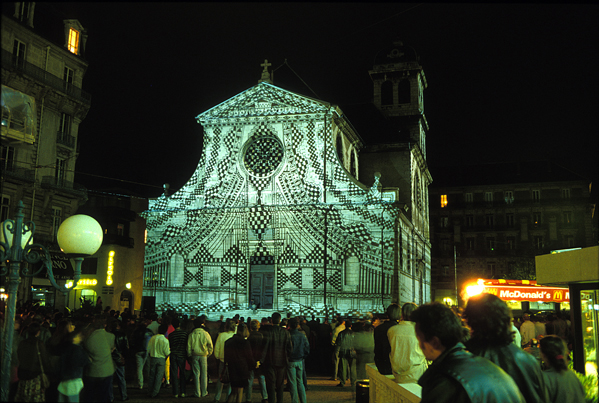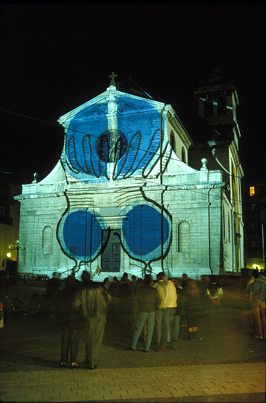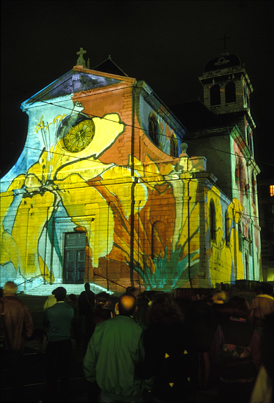Feb 19, 2012 | Laboratoire en
Aiming to question the dialogue between the façade and the city, Philippe Mouillon carefully draws a precise sketch-outline of the façades of the cathedral of Grenoble and distributes it to 150 contemporary artists living all around the world.
Each artist is invited to give his personal vision of this original surface, with reference to his own inner landscape, giving his own view of the space – enriched, diverted or inverted. This interpretation is bound to be uncertain, for the artists associated with this project are more or less distant from the site. They are living in a symbolic spatial paradigm, sometimes totally different from this cathedral situated in Western Europe, sometimes in a real proximity that is so obvious that it needs no interpretation…
This conjunction between local identity and planetary imagination disrupts our certitudes.
We are in 1989 and the word globalization is not yet in use, but the change of scale of our territorial marks is already perceptible.



Rissa Ixa

COMMENTS BY PIERRE GAUDIBERT / PIERRE RESTANY
The whole planet, in the end…
Pierre Gaudibert :
– The ambition of Façades Imaginaires is to act as an urban meeting point for planetary imagination! On the façade of Saint-Louis Church, an 18th century structure situated in the middle of Grenoble, the work of over a hundred contemporary artists from all over the world will be projected, thanks to a totally unusual operation. This is Laboratoire’s latest production in a long line of innovative, multimedia, ephemeral, urban events.
Pierre Restany :
– The idea is perfectly encapsulated in the title, containing as it does a fundamental reference to a town’s capacity for self-expression and its enormous reserves of forms, images, languages and ultimately poetry. An exhibition of this sort is clearly an answer to my prayers; for over 35 years I have been passionately involved with the problem of modern nature, in other words urban, industrial, advertising and media nature. What is a façade? According to the dictionaries it is above all the front of a building. But by always showing what is up front, the rest of the building is taken over by imagination and disappears into an endless maze.
A façade is the most stimulating of outward appearances, a point of departure for a host of urban fantasies. Every citizen shares this form of urban fancy, and each may draw satisfaction from it while a small number may actually find here more tangible or original inspiration.
Pierre Gaudibert :
– In this period of crisis and uncertain transition, a huge operation is under preparation to crossbreed individual, imaginary productions. An intermingling that will make possible a host of dialogues, exchanges, puzzles, hybridization, mixtures, syncretism, symbiosis, synthesis, and lastly some sort of crossbreeding. These imaginary productions are neither collective, nor anonymous, nor tribal; they express individual creativity, rooted in culture or uprooted from it, specific identities, local or nomadic, or the fruit of crossbreeding. They reflect the rich diversity of a world in the making.
Pierre Restany :
– An exemplary illustration of the language of modern, urban nature is to be found in the work of the new, European realists, who have highlighted this type of reality admirably and the many ways of appropriating it. Compression, accumulation, packets, targets and traps, lacerated billboards; these are all variations on the theme of urban imagination and its appropriation. And now some thirty years later, Philippe Mouillon has rediscovered this fundamental theme, updated it. The timing of the event is perfect, coinciding with the collapse of industrial society and the rise of post-modernism! The Façades Imaginaires concept contains all the possibilities for self-expression normally found in urban, industrial folklore but simultaneously transcends formal appearance in the name of man and his imaginative fantasy.
Pierre Gaudibert :
– This is of considerable importance: it represents the dual refusal of standardization by the dominant mass cultures and a standard, uniform, “international” art, insipid and monotonous. Crossbreeding does not necessarily involve removing differences. On the contrary it may generate new, plural identities and enrich individuals and peoples. It announces the decline of Euro-centrality.
The world-wide artistic heritage which is in the process of developing, for tomorrow, will be born of such encounters, which will proliferate to cover the whole planet, in the end…
Feb 19, 2012 | Laboratoire en
The village church in Péage de Roussillon overlooks the Rhone valley for centuries. A place with powerful memories, it is anchored in identities shared by everybody, whose symbolic function is however no longer questioned by the test of everyday life.
This church was stormed by Maryvonne Arnaud in 1987: standing on a high-lift truck parked a few meters away from the church frontage, she has for a few hours taken a comprehensive set of detailed shots. 110 images, approximately one metre square, taken from the front without vanishing lines, which recreated the whole façade.
But the rigour of this systematic shooting does not hide the weaknesses of the photographer, on the contrary it shows some loss of details, some spatial inconsistencies, and brings out the physical challenge of this long commitment.
These fragments are then reproduced full scale, then put together on a network of cables strung across the front of the building.




Far from recreating the original façade, the monumental work re-composes it in another spatial and temporal dimension: each puff of wind makes the 150 square meters of this façade of sensitive paper flutter in the wind and escape from gravity towards to live a new life with baroque hues!
Three years in a row, and in three different cities of the Rhône Valley, including Arles during the Rencontres Internationales de la Photographie, Maryvonne Arnaud systematically shoots the façade of a particular building, before delivering it to the Mistral wind.





Feb 19, 2012 | Laboratoire en
World-workshop tries to initiate a process of inquiry interfacing with the public, as a loop that asks, as an incubation device intended to rebuild the life of the city. This back and forth between the concrete and daily experience of each one – located here, and experiences of a multitude of authors – scattered around the world, renew the public space by snatching it from the rigidities inherited from the usual to unfold other coherences.
The circle of writers associated from the beginning to the world-workshop: artists Maryvonne Arnaud and Philippe Mouillon, sociologists Yves Chalas et Henry Torgue, philosophers Daniel Bougnoux et Yves Citton, clearly stated this postulate inviting living authors in the Rhone-Alpes region such as Jean-Pierre Chambon, Olivier Frérot, Luc Gwiazdzinski, Bernard Fort, Xavier Garcia, and confronting them to others, scattered throughout the world, such Bruno Latour, Stefano Boeri, Janek Sowa, François Ascher, Abdelwahab Meddeb, Osamu Nishitani, Patrick Chamoiseau, Bernard Stiegler, Augustin Berque, Thanh Nghiem, Aude Merlin,…
World-Workshop sets the aesthetic representations at the heart of exchange. Each workshop is open and relies on images, movies, sound fragments, many clues of the world that stimulate and provoke thought, but that also and especially help to preserve an intellectual exchange accessible to ordinary citizens, who is more intuitive and open to the intimate experience.
This device attempts to make visible the unthought of the time, the fragilities of representations and dominant interpretations of a real that escapes and is never where one looks for, or as expected.



Feb 16, 2012 | local contemporain en
« local.contemporain » is a centre of research and original artistic initiatives around contemporary urban territories, an enterprise to renew our look, with a particular care for emerging forms and experiences.
« local.contemporain » examines, in the usual local habits , the innovative particularities or the ones that resist to the global mutations of our societies.
This strategy of hyper-localised questioning is developed with a particular care for the global scale of mutations and for the abundant complexity of the involved temporalities. That is why artists and researchers coming from all over the world are associated to this initiative, looking for numerous urban tools to think about this territory.
We publish an 80-page review distributed in bookstores by Harmonia-Mundi.
Nine issues are published to date: 01> you are here focused on the contemporary realities of ordinary urban forms, 02> It’s Sunday! devoted to the analysis of free time in a so-called “leisure” society, 03> invisible city analyzes sensitive urban forms, those which escape the domination of the eye but structure our perceptions, 04> the precarious, contemporary questions, on the precariousness of our lives as a new dominant form, 05> Crowds centered on the experience of the crowd, alternately worrying or intelligent, 06> Points of reference, around the feeling of disorientation of a growing share of the population , 07> a world of its own or how each one builds its own landmarks in a globalized horizon, 08> collection of collections about the place of privacy in the public space, 09> singular landscapes, pluralistic landscape to approach the Landscape as a resource within reach of all, and live with scope.
> We produce interventions of urban scales in the real space of the city, in order to shape these representations for the man of the street. They invite the participation of hundreds of contributors.
Thus It is Sunday, a random collection of photographs:

> We develop pedagogical tools for teachers from kindergarten to university.
Thus cartographic games:

Visit the site local.contemporain


















